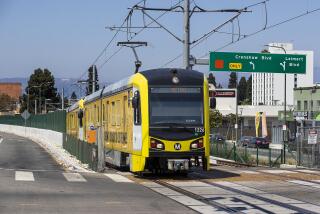2 Valley Rail Lines Feasible, Studies Say : Transportation: Either an elevated route or a subway could be streamlined to cut costs, preliminary engineering findings conclude.
Preliminary findings from two engineering studies show that both above- and below-ground rail lines across the San Fernando Valley floor are feasible and that either project could be streamlined to reduce costs, transit officials said Monday.
In a briefing prepared for the Metropolitan Transportation Authority, planners say both a subway system paralleling Burbank Boulevard and an elevated line straddling the Ventura Freeway could be built without running into unfriendly soil conditions or unduly disrupting traffic.
Both options could also realize cost savings if they included new station designs, more efficient construction techniques and the postponement of some station openings, planners said.
But no hard numbers are yet available on the projected savings, which will probably be the deciding factor for the cash-strapped MTA when its directors approve a final route later this year, resolving a debate that has dragged on for years.
Cost comparisons are expected this summer after the two engineering studies, now 70% done, are finally completed.
“The costs are the big numbers that everyone wants to know about. Those are due in August,” said David L. Mieger, project manager for the east-west Valley rail line.
“With our deficits right now, we’re looking at every dollar we spend,” Mieger said. He declined to speculate which option might ultimately be cheaper.
Currently, projections tab the Ventura Freeway line--which the MTA tentatively approved two years ago, pending the outcome of the studies--at $2.6 billion, while the price tag on the subway system is an estimated $3 billion.
The preliminary report released Monday indicates that freeway widening for construction purposes and stricter seismic standards in the wake of the Northridge earthquake would increase costs for the overland route.
Those increases might reduce some of the potential savings from measures such as performing some construction and assembly off-site and delaying station openings where ridership is expected to be lower. But officials predict a net gain for the transit agency, which faces an operating deficit next year of $126 million.
An extension of the Red Line subway from North Hollywood to Warner Center could also be built at less than the expected $3 billion, analysts said.
Because the line would not run under major streets, stations could be open-air and would not need the intense ventilation and lighting required at stations in Downtown Los Angeles and those under construction along the Hollywood segment.
This could result in savings of as much as 30% to 40% per station, helping to “significantly reduce the estimated costs” of the subway, the report said.
More to Read
Sign up for Essential California
The most important California stories and recommendations in your inbox every morning.
You may occasionally receive promotional content from the Los Angeles Times.










